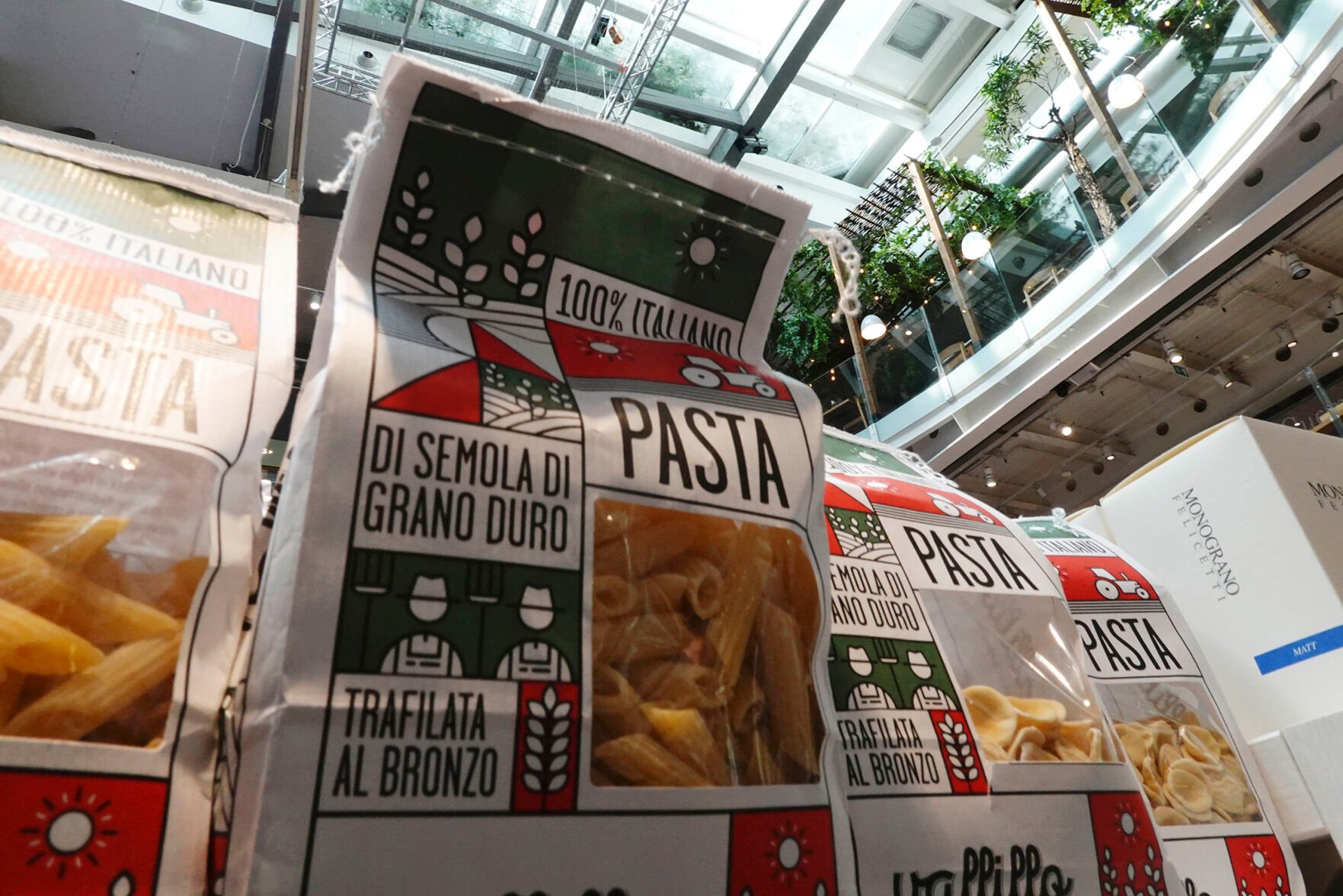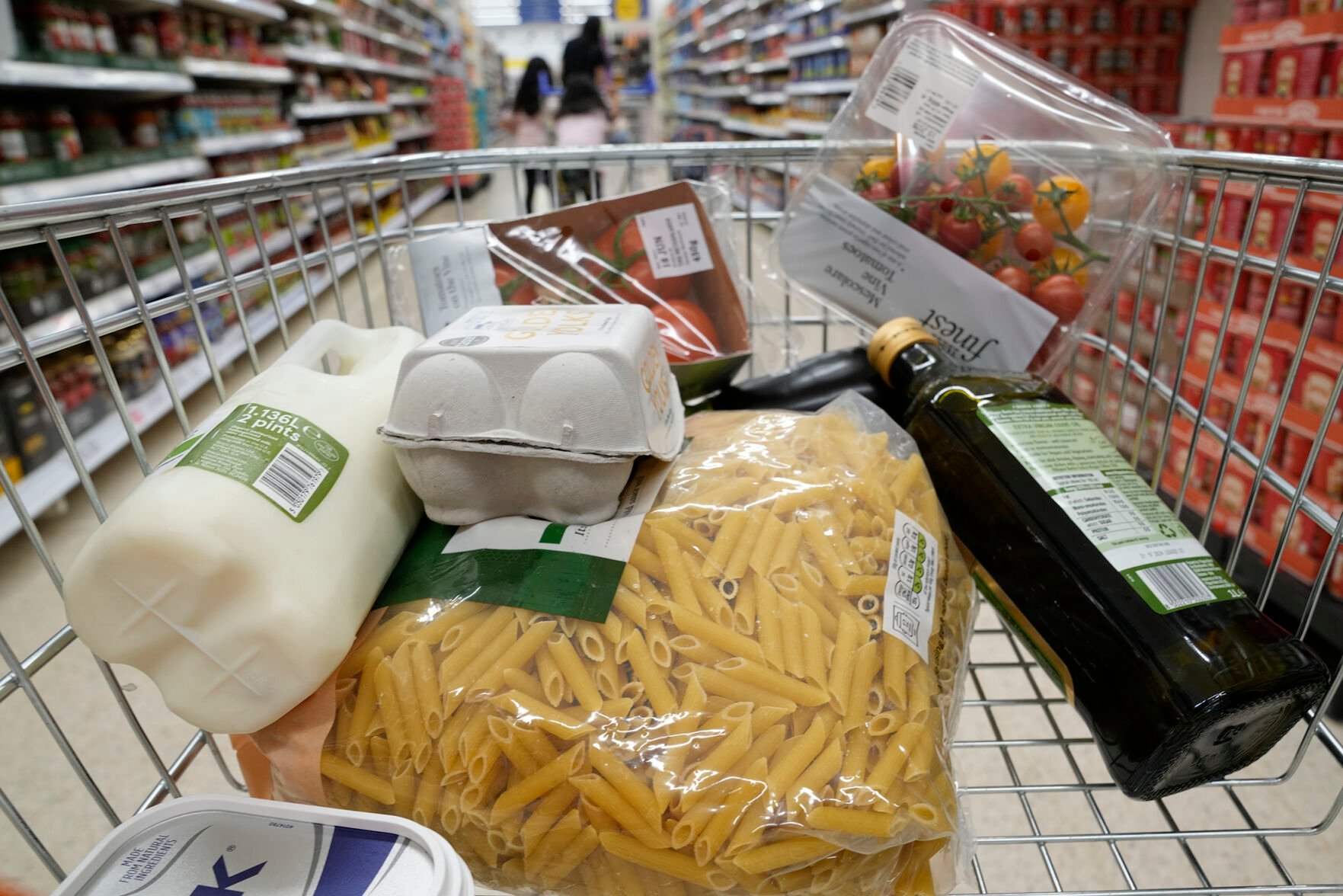MILAN — When it comes to skyrocketing pasta prices, Italians are crying: Basta!
They’ve had enough after the cost of the staple of every Italian table soared by twice the rate of inflation. One consumer advocate group is calling for a weeklong national pasta strike starting June 22 after the Rome government held a crisis meeting last month and decided not to intervene on prices.
“The macaroni strike is to see if keeping pasta on the shelves will bring down the prices, in the great Anglo-Saxon tradition of boycotting goods,” said Furio Truzzi, president of the group, Assoutenti. “The price of pasta is absolutely out of proportion with production costs.”
Grocery prices have risen more sharply in Europe than in other advanced economies — from the U.S. to Japan — driven by higher energy and labor costs and the impact of Russia’s war in Ukraine. That is even though costs for food commodities have fallen for months from record highs, including wheat for the flour used to make pasta.

Luca Bruno, Associated Press
A man eats pasta Thursday in a restaurant in Milan, northern Italy.
Stores and suppliers have been accused of profit-padding “greedflation,” but some economists say retail profits have been stable and the problem comes down to the higher cost to produce food.
Feeling the pressure, some governments in Europe have capped prices on staples or pushed for agreements with grocery stores to bring down costs, something that’s popular with the public but can actually make food prices worse.
Shoppers like Noée Borey, a 26-year-old picking up groceries at a chain store in Paris, said she is all for setting ceilings for some food to help low-income workers and students.
She buys less meat and opts for less expensive grocery stores.
“Inevitably, all the products I buy have gone up by 20%, whether it’s butter or berries,” Borey said. “I’m not buying cherries anymore because they cost 15 euros a kilo” (about $8 a pound).

Luca Bruno, Associated Press
Packages of pasta are displayed Thursday in a supermarket in Milan, northern Italy.
The French government reached a three-month agreement with supermarket chains for them to cut prices on hundreds of staples and other foods, which is expected to be extended through the summer. Britain — where food inflation has reached 45-year highs — is discussing a similar move.
Countries like Hungary, with the highest food inflation in the European Union, and Croatia have mandated price controls for items like cooking oil, some pork cuts, wheat flour and milk.
The Italian government says it will strengthen price monitoring by working more closely with the country’s 20 regions but won’t impose such limits.
Spain has avoided price controls but abolished all value-added tax on essential products and halved tax on cooking oil and pasta to 5%.
The measures come as food banks are seeing soaring demand in some countries.
“Things are not getting better, they are getting worse for people,” said Helen Barnard of the Trussell Trust, a charity that operates more than half of the food banks in the United Kingdom.

Luca Bruno, Associated Press
Customers look at packages of pasta Thursday in a supermarket in Milan, northern Italy.
Spending much more to buy essentials like milk, pasta and fresh vegetables to “top up” donations received from supermarkets is a struggle for Anna Sjovorr-Packham, who runs several community food pantries serving discounted groceries to some 250 families in south London.
“While the demand from families hasn’t gone up hugely, the cost has, and that’s been really difficult to support,” she said.
Inflation on food and non-alcoholic drinks has actually fallen in Europe, from 17.5% in the 20-country euro area in March to a still-painful 15% in April. It comes as energy prices — key to growing and transporting what we eat — have dropped from record highs last year. But economists say it will be many months before prices in stores settle back down.
In comparison, U.S. food prices rose 7.7% in April from a year earlier, 8.2% in Japan and 9.1% in Canada. They hit 19% in the U.K.
The numbers play into expectations that the European Central Bank will raise interest rates again this week to counter inflation, while the U.S. Federal Reserve is expected to skip a hike.

Alastair Grant, Associated Press
A basket of groceries is seen Saturday at a supermarket in London.
In Europe, turning to price controls plays to voters, who get constant reminders of the inflation every time they hit the checkout counter, said Neil Shearing, group chief economist for Capital Economics. But he said such changes should be reserved for instances of supply shocks, like war.
Such controls could actually make food inflation worse by increasing demand from shoppers but discouraging new supply, he said.
“The current food price shock does not warrant such intervention,” Shearing said.
-
As food prices remain high, some states put grocery taxes on ice
eldar nurkovic // Shutterstock
If you're feeling like grocery prices have inched up seemingly overnight, you're not alone. The last time grocery costs spiked this much was in 1980, when the U.S. was coming off more than a decade of rising prices in the wake of higher government borrowing and spending spurred by World War II and the Vietnam War.
Today, few seem to agree on what's behind rapid inflationary growth. Some business leaders, politicians and economists link increasing wages, while others say pandemic stimulus checks issued to consumers and businesses play a big part. Then there's Russia's war with Ukraine, major supply chain disruptions and record corporate profits. Time will tell which may be the driving factor.
For now, nearly everyone can agree that the result is the same: rising costs are hitting Americans' wallets. An estimated 93% of U.S. adults surveyed said the prices of goods in their metro area increased over the last two months, according to the Census Bureau's Oct. 5 Household Pulse Survey. The same survey found that 83% of adults said they're somewhat or very concerned about additional price increases over the next six months—an understandable reaction for anyone who has walked past a grocery store shelf recently.
Food at home, the term used by statistical agencies to describe grocery items purchased to eat at home, rose in price by 11.2% year over year in September 2022, according to the Bureau of Labor Statistics (BLS). The BLS gathers information about the prices of goods by sending researchers to visit retail stores in major metro areas and report the prices of commonly purchased items, including eggs, coffee, and meats.
Experian created a hypothetical basket of commonly purchased food items to illustrate how the affordability of essential foods has shifted in recent years for the American consumer. This analysis uses price data from the BLS, wage data from the Census Bureau, and news reports on inflation. Continue reading to learn how food price inflation is hitting home across the country.

eldar nurkovic // Shutterstock
If you're feeling like grocery prices have inched up seemingly overnight, you're not alone. The last time grocery costs spiked this much was in 1980, when the U.S. was coming off more than a decade of rising prices in the wake of higher government borrowing and spending spurred by World War II and the Vietnam War.
Today, few seem to agree on what's behind rapid inflationary growth. Some business leaders, politicians and economists link increasing wages, while others say pandemic stimulus checks issued to consumers and businesses play a big part. Then there's Russia's war with Ukraine, major supply chain disruptions and record corporate profits. Time will tell which may be the driving factor.
For now, nearly everyone can agree that the result is the same: rising costs are hitting Americans' wallets. An estimated 93% of U.S. adults surveyed said the prices of goods in their metro area increased over the last two months, according to the Census Bureau's Oct. 5 Household Pulse Survey. The same survey found that 83% of adults said they're somewhat or very concerned about additional price increases over the next six months—an understandable reaction for anyone who has walked past a grocery store shelf recently.
Food at home, the term used by statistical agencies to describe grocery items purchased to eat at home, rose in price by 11.2% year over year in September 2022, according to the Bureau of Labor Statistics (BLS). The BLS gathers information about the prices of goods by sending researchers to visit retail stores in major metro areas and report the prices of commonly purchased items, including eggs, coffee, and meats.
Experian created a hypothetical basket of commonly purchased food items to illustrate how the affordability of essential foods has shifted in recent years for the American consumer. This analysis uses price data from the BLS, wage data from the Census Bureau, and news reports on inflation. Continue reading to learn how food price inflation is hitting home across the country.

-
As food prices remain high, some states put grocery taxes on ice
DGLimages // Shutterstock
This basket of groceries costs $72 in 2022 and includes:
- 3 pounds of bananas
- 5 pounds of oranges
- 5 pounds of tomatoes
- 2 loaves bread
- 4 pounds of chicken
- 12 eggs
- 3 pounds of ground beef
- 5 pounds of potatoes
- 1 pound of coffee grounds
- 2 gallons of milk
The basket items reflect a subjective selection of common weekly grocery items for a small household. Chosen from among food items and prices tracked by the BLS, the groceries were assigned an average price that was calculated by dollars per pound, with the total basket cost adding up to 5% of median household income.
DGLimages // Shutterstock
This basket of groceries costs $72 in 2022 and includes:
- 3 pounds of bananas
- 5 pounds of oranges
- 5 pounds of tomatoes
- 2 loaves bread
- 4 pounds of chicken
- 12 eggs
- 3 pounds of ground beef
- 5 pounds of potatoes
- 1 pound of coffee grounds
- 2 gallons of milk
The basket items reflect a subjective selection of common weekly grocery items for a small household. Chosen from among food items and prices tracked by the BLS, the groceries were assigned an average price that was calculated by dollars per pound, with the total basket cost adding up to 5% of median household income.
-
-
As food prices remain high, some states put grocery taxes on ice
Experian
The same basket of food items that cost $72 in 2022 would have rung up to about $60 in 2002 (in today's dollars). A shopper could add more food into the hypothetical basket than they could today, reflecting a stronger purchasing power 20 years ago.
In 2003, the Labor Department recorded a 40-year low in inflation for consumers. This year, the inflation rate for consumers reached a 40-year high. As Americans grapple with rising costs for goods, some are cutting back or even borrowing money to fund purchases of necessities like food.
Experian
The same basket of food items that cost $72 in 2022 would have rung up to about $60 in 2002 (in today's dollars). A shopper could add more food into the hypothetical basket than they could today, reflecting a stronger purchasing power 20 years ago.
In 2003, the Labor Department recorded a 40-year low in inflation for consumers. This year, the inflation rate for consumers reached a 40-year high. As Americans grapple with rising costs for goods, some are cutting back or even borrowing money to fund purchases of necessities like food.
-
As food prices remain high, some states put grocery taxes on ice
Experian
The median income for American households took a big hit when the country entered the Great Recession, beginning its fall in 2008 and requiring almost an entire decade to return to pre-recession levels.
Americans' annual median household income changed at a statistically insignificant level from 2020 to 2021—before accounting for stimulus payments in the first year of the COVID-19 pandemic, according to the Census Bureau.
The median household's earnings declined from $71,186 in 2020 to $70,784 in 2021, according to the most recent Census household income estimate. The 2022 median household income is estimated to rise to $75,000 for 2022. Using quarter-over-quarter wage data from Q3 2022, this estimate calculates the rate of change from the prior year to determine a projection for 2022 median household income.
Experian
The median income for American households took a big hit when the country entered the Great Recession, beginning its fall in 2008 and requiring almost an entire decade to return to pre-recession levels.
Americans' annual median household income changed at a statistically insignificant level from 2020 to 2021—before accounting for stimulus payments in the first year of the COVID-19 pandemic, according to the Census Bureau.
The median household's earnings declined from $71,186 in 2020 to $70,784 in 2021, according to the most recent Census household income estimate. The 2022 median household income is estimated to rise to $75,000 for 2022. Using quarter-over-quarter wage data from Q3 2022, this estimate calculates the rate of change from the prior year to determine a projection for 2022 median household income.
-
-
As food prices remain high, some states put grocery taxes on ice
Experian
Americans spent more than 14% of their pretax income on food in the 1960s, but since the turn of the millennium, that spending has hovered around 10%. That typically splits into about 5% going toward eating out and 5% for groceries consumed at home, according to the USDA.
A consumer earning the median weekly income who spends 5% of their income on groceries to eat home would have only had to spend 3% on the same basket of groceries in 2002 dollars.
Americans spent far more of their earnings on food decades ago, but that percentage has declined as U.S. agriculture became more productive by introducing new technologies.
This story originally appeared on Experian and was produced and distributed in partnership with Stacker Studio.
Experian
Americans spent more than 14% of their pretax income on food in the 1960s, but since the turn of the millennium, that spending has hovered around 10%. That typically splits into about 5% going toward eating out and 5% for groceries consumed at home, according to the USDA.
A consumer earning the median weekly income who spends 5% of their income on groceries to eat home would have only had to spend 3% on the same basket of groceries in 2002 dollars.
Americans spent far more of their earnings on food decades ago, but that percentage has declined as U.S. agriculture became more productive by introducing new technologies.
This story originally appeared on Experian and was produced and distributed in partnership with Stacker Studio.




